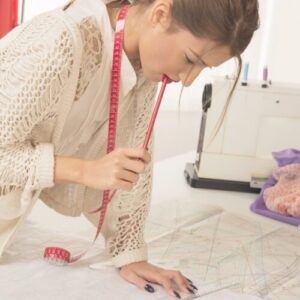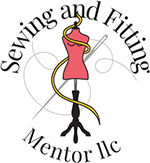
Choosing sewing patterns is fun and exciting! However, selecting a pattern that matches your skill level and size can seem like a daunting task even for the not-so-new sewist.
Start with matching the pattern’s level of sewing difficulty to your own sewing experience. For best results, select a pattern that is appropriate to your skills and knowledge of fabric as well.
Also, if your time or patience is limited, stick with simpler styles. If the sewing level is not indicated on the outside of the pattern; you can check the instruction sheet inside the pattern envelope for the number of pattern pieces for your pattern choice which can help determine its level of difficulty. The fewer the pieces, the easier the pattern.
Keep in mind, garment details such as closures, collars, cuffs, pleats, and tucks can also increase the difficulty of a pattern. Easy-to-sew patterns feature few of these details.
Start with selecting your sewing experience & skill level
- Novice-No experience with sewing or exceptionally minimal.
- Beginner-You’ve had some introductory sewing lessons either at school, online, or from a more experienced sewer and would like to create items that you can actually wear or use! You have used a sewing machine before but need a refresher on threading the machine. You’re also unsure about the tension dial & what is sewing tension and you may need more practice keeping an even seam allowance. You have finished some projects. However, you also have many unfinished projects due to difficulty understanding patterns.
- Advanced Beginner-You understand pattern markings, can confidently follow pattern instructions, sew a straight and curved seam while keeping even seam allowances. You are ready to learn about darts and practice adding fastenings (buttons, zippers, snaps & velcro), and progress to inserting pockets and waistbands into garments. You are also ready to start sewing knits and garments with a little stretch. You’re able to thread your own machine, wind a bobbin, and troubleshoot tension issues (with guidance). You have a basic understanding of different fabric types. You have several projects under your belt and you have some experience using basic patterns
- Intermediate-You enjoy making your own clothing and are able to make basic fitting changes to a pattern your desired results (like lengthening or shortening a hem or narrowing a waist by bringing in a side seam or increasing a dart). You have been sewing for a while and are comfortable sewing from patterns. You have a general understanding of fabric types and composition (including interfacings and how they are used). You can find the grainline. You have experience using different presser feet, inserting zippers, making buttonholes, sizing patterns, transferring patterns, cutting fabric, and matching pattern pieces. Although you could learn more techniques for any or all of the above. You want to learn more about how to get a really great fit and become confident achieving some finer details like welt pockets and linings. You may have worked with knits, used a serger or a cover hem machine and if not you are ready to learn!
- Advanced-You are obsessed and your idea of bliss is spending unlimited hours sewing or in a fabric shop of designer fabrics dreaming of the possibilities. You may even are beginning to making your own patterns and will confidently tackle advanced projects (like tailored jackets, pants, or special occasion wear). While seeking to have polished, professional results in your custom clothing.
- Couture-experience in pattern making, couture sewing, and advanced fitting techniques.
Finding your correct pattern size
All pattern companies follow uniform sizing based on standard body measurements. This is not the same as ready-to-wear sizing in which sizes are determined by each clothing manufacturer.
Thus, the reason behind different clothing sizes when you’re shopping for jeans for instance.
To select your correct pattern size, first, take your personal body measurements. Wear your usual undergarments, a semi-fitted tank top or t-shirt, and leggings that won’t distort your body shape, and use a flexible tape measure that doesn’t stretch.
For accuracy, have another person measure you.
Record your measurements and compare them with the pattern company measurement chart.
| Your Measurement | Pattern Measurement | Pattern Size | |
| High Bust (A) | |||
| Full Bust (B) | |||
| Waist (C) | |||
| Hip (D) | |||
| Back Waist Length (E) | |||
| Height (F) |
A) High Bust- Place the tape measure under arms across the widest part of the back and above the full bustline. Pattern charts do not include a high bust measurement. However, this measurement should be compared with the full bust measurement to assist in choosing the correct pattern size.
B) Full Bust- Place the tape measure under arms, across the widest part of the back and the fullest part of the bustline. *NOTE: if there is a difference of 2” (5 cm) or more between high bust and full bust, select pattern size by full bust measurement.
C) Waist- tie a string or ¼ inch elastic around your middle, lean forward, back and forth, side to side to allow to roll to your natural waistline. Measure at this exact location with a tape measure (don’t suck in your belly) Leave the string in place as a reference for measuring hips and back waist length.
D) Hip- Measure around the fullest part. This will be approximately 7” to 9” inches below the waistline depending on your height.
E) Back Waist Length- Measure from the middle of the most prominent bone at the base of the neck to the waistline string.
F) Height-Measure without shoes. Stand with your back against the wall. Place a ruler on top of your head and mark the wall. Measure from the mark to the floor.
Compare your measurements with the pattern company size chart I’ve like McCall’s Misses’/Misses’.
Locate your figure type, then locate the column numbers that most closely match your measurements. Select your dress, blouse, and suit patterns by bust size; pants and skirt patterns by hip size.
For more information on choosing your correct pattern size check out the following links
Still need help see my list of services and contact me for an appointment.

Leave a Reply